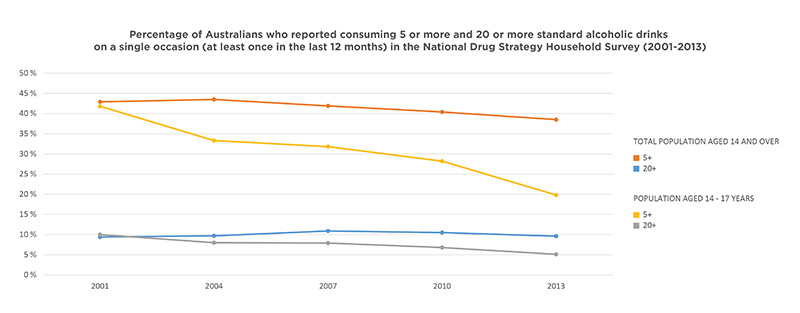Great news this week, with a new study on Australian drinking patterns finding that the number of underage teens who are binge drinking has decreased by half in 13 years, and the number of young abstainers has more than doubled.
Understanding recent trends in Australian alcohol consumption draws insights from five waves of the Australian Institute of Health and Welfare’s (AIHW) National Drug Strategy Household Survey (2001 to 2013) involving more than 120,000 respondents.
The AIHW survey has been conducted by Roy Morgan Research every few years since the mid-80s, and it provides a large quantity of rich data which examines alcohol, tobacco and illicit drug use in Australia.
This latest report from the Foundation for Alcohol Research and Education (FARE) breaks down the AIHW’s population wide findings by a range of demographic factors such as age, gender, location, socioeconomic status, and cultural background in order to provide a more complete picture of what’s going on.
It found that the rates of heavy drinking have remained stable among young adults (18-29 year olds). Of concern, Australia’s older population (those aged 30 and over) have actually increased their alcohol intake, putting them at greater risk of short and long term harm.
But it’s the youngest cohort of Aussies aged between 14 and 17 who have shown the most encouraging trend.
Young people have sharply reduced their drinking over the last decade. In particular Australian teenagers are drinking less alcohol and in less risky quantities – welcome news for those working in the public health, education and emergency services sectors.
In 2001 ten per cent of 14 to 17 year olds surveyed reported drinking 20 or more standard drinks in a session at least once in the last 12 months. And 41.8 per cent had consumed five or more standard drinks on an occasion.
This is twice the rate seen in the current 2013 survey data.
Now only 5.1 per cent of Australians aged 14 to 17 report binge drinking on 20 or more standard drinks and 19.8 per cent have consumed five or more drinks in an occasion.
This dramatic decline in underage binge drinking is due, at least in part, to the growing number of young people who are avoiding alcohol altogether.
More than half (57.3 per cent) of Australians aged between 14 and 17 abstain from drinking alcohol, compared to just 28 per cent in 2001.
The decline in underage drinking in Australia is in line with worldwide trends. Similar patterns have been seen in the United Kingdom, Sweden and New Zealand.
FARE Chief Executive Michael Thorn was encouraged by the findings, noting that these patterns of behaviour will significantly improve the health of young Australians.
“There is no level of safe drinking for those aged under 18, as alcohol can damage the developing brain, so it is extremely pleasing to see such a positive and significant shift in young people’s drinking patterns,” Mr Thorn said.
There are a number of theories behind why we’re seeing less underage drinking. A shift towards socialising activities which don’t revolve around alcohol, along with a growing focus on healthy living may have contributed to the decline.
But, as Mr Thorn notes, the role played by the public health sector should definitely not be underestimated.
“By raising the awareness of alcohol harms, by supporting the introduction of secondary supply laws and by better informing and empowering parents that it’s important that they say ‘no’ to providing alcohol to their children, organisations such as FARE and the public health sector have undoubtedly created an environment conducive to the positive change we are now witnessing,” Mr Thorn said.
“Young people are leading the way in changing Australia’s relationship with alcohol. It is important that Australian governments at all levels continue to work together to ensure that this positive momentum continues. Just as importantly, we must continue to focus our attention on those groups of Australians that this study has identified as still drinking at risky levels,” Mr Thorn said.









3 comments